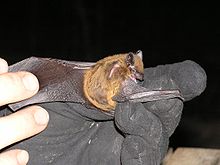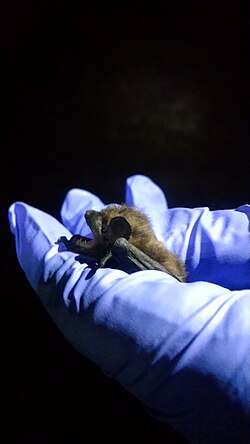| Evening bat | |
|---|---|

| |
| Conservation status | |
 Least Concern (IUCN 3.1) | |
| Scientific classification | |
| Domain: | Eukaryota |
| Kingdom: | Animalia |
| Phylum: | Chordata |
| Class: | Mammalia |
| Order: | Chiroptera |
| Family: | Vespertilionidae |
| Genus: | Nycticeius |
| Species: | N. humeralis |
| Binomial name | |
| Nycticeius humeralis (Rafinesque, 1818) | |

| |
The evening bat (Nycticeius humeralis) is a species of bat in the vesper bat family that is native to North America. Hunting at night, they eat beetles, moths, and other flying insects.
Description
 An evening bat in the hands of a researcher
An evening bat in the hands of a researcher
The evening bat is a small bat weighing 7–15 g (0.25–0.53 oz) found throughout much of the midwestern and eastern United States. Their forearms are 34–38 mm (1.3–1.5 in) in length. The tip of each dorsal hair is a light gray, and one to two-thirds of the basal is dark brown. Though there have been some cases of white pelage, the majority of the population is mostly brown in color. They have wide, dog-like muzzles, pronounced facial glands, and disproportionately large bacula. Evening bats can be mistaken for juvenile big brown bats, due to their physical resemblance but smaller size.
Morphology
Evening bats have relatively robust jaws, compared to other insectivorous bats. They have an unkeeled calcar and a short, round tragus. The curvature of the tragus helps distinguish it from bats of the genus Myotis, which otherwise look very similar. Their skull has one upper incisor on each side with 4 molariform teeth.
Biology
The evening bat is a relatively short-lived, especially compared to other bats in its geographic range. It has a maximum age of 6 years, though few individuals live past 4 years. Its short lifespan for a bat could be explained by its considerably higher reproductive output. Bats that only have one pup per year would need to live much longer to have the same fitness as a shorter-lived species with two or three pups per year.
Reproduction
Evening bats mate in the fall and winter; the sperm is stored until the spring, when fertilization occurs. Female bats form maternity colonies in May, consisting of 15-300 individuals. Of females that give birth, 90% have twins, but singletons and triplets are also possible. Though it is more common for evening bats to nurse their own offspring, a small proportion of offspring are nursed by unrelated females. The pups are capable of flight within a month of birth. Pups are weaned within 42 days of birth. Female pups exhibit natal philopatry, meaning that as adults, they return to the roost where they were born to give birth.
Diet
These bats have varied diets. A majority of the bats' diet in Indiana and Illinois are beetles, including the spotted cucumber beetle, which is a serious agricultural pest. In southern Illinois, the spotted cucumber beetle is almost 25% of the evening bats' diet. Other beetles consumed include ground beetles and scarab beetles. Moths are also a significant dietary component. Bugs, winged ants, and flies are prey items of less significance. Evening bats partition resources with other insectivorous bats in their range, such as the eastern red bat and Seminole bat. Despite foraging in the same areas at the same time, these three bat species choose different prey items at different points throughout the summer.
Distribution
At first, the evening bat was thought of as a southeastern bat species. However, breeding evening bats have been found as far north as Michigan and as far west as the 100th meridian. Evening bats roost in a variety of structures, including Spanish moss, under bark, in tree cavities, and in buildings. For foraging habitat, evening bats in Georgia prefer pine forest, riparian zones, and open fields. Evening bats have home ranges of approximately 300 hectare (1.15 mi). Because the evening bat is not found in the northernmost extent of its range in the winter, it is likely that at least some evening bats are migratory.
Conservation
While the evening bat is considered endangered in the state of Indiana, it has a cosmopolitan distribution throughout the southeast and midwest. Because evening bats do not enter or hibernate in caves, the species is not at-risk from white-nose syndrome, which has killed over six million bats in the United States since 2006. The evening bat's avoidance of this disease, along with die-offs of many other species, is possibly responsible for the evening bat recently expanding its range into Wisconsin in 2015 and Minnesota in 2016.
| State | Conservation Status |
|---|---|
| Alabama | Lowest Conservation Concern |
| Arkansas | Not listed |
| Florida | Not listed |
| Georgia | Not listed |
| Illinois | Not listed |
| Indiana | State Endangered |
| Iowa | Not listed |
| Kentucky | Threatened |
| Kansas | Not listed |
| Louisiana | Not listed |
| Maryland | Not listed |
| Michigan | Threatened |
| Minnesota | Not listed |
| Mississippi | Not listed |
| Missouri | Not listed |
| Nebraska | Not listed |
| North Carolina | Not listed |
| Ohio | Species of Special Interest |
| Oklahoma | Not listed |
| Pennsylvania | Not listed |
| South Carolina | Not listed |
| Tennessee | Not listed |
| Texas | Not listed |
| Virginia | Not listed |
| West Virginia | Not listed |
| Wisconsin | Not listed |
References
- Solari, S. (2019). "Nycticeius humeralis". IUCN Red List of Threatened Species. 2019: e.T14944A22015223. doi:10.2305/IUCN.UK.2019-1.RLTS.T14944A22015223.en. Retrieved 19 November 2021.
- Simmons, N.B. (2005). "Order Chiroptera". In Wilson, D.E.; Reeder, D.M (eds.). Mammal Species of the World: A Taxonomic and Geographic Reference (3rd ed.). Johns Hopkins University Press. pp. 312–529. ISBN 978-0-8018-8221-0. OCLC 62265494.
- ^ Wilkinson, G.S. (1992). "Communal Nursing in the Evening Bat, Nycticeius humeralis". Behavioral Ecology and Sociobiology. 31 (4): 225–235. doi:10.1007/bf00171677. S2CID 15560376.
- ^ Watkins, L. C. (1972). Nycticeius humeralis. Mammalian species, (23), 1-4.
- Hamilton, W. J. (1949). "The bacula of some North American vespertilionid bats". Journal of Mammalogy. 30 (2): 97–102. doi:10.2307/1375254. JSTOR 1375254. PMID 18121317.
- Freeman, P. W. (1981). "Correspondence of food habits and morphology in insectivorous bats". Journal of Mammalogy. 62 (1): 166–173. doi:10.2307/1380489. JSTOR 1380489. S2CID 12934993.
- ^ Barbour, R., W. Davis. 1974. Mammals of Kentucky. Kentucky: The University Press of Kentucky.
- Whitaker, John O. (2010). Mammals of Indiana. Bloomington, IA: Indiana University Press. pp. 118 & 119. ISBN 978-0-253-22213-8.
- ^ Austad, S. N. (2010). Cats,"rats," and bats: the comparative biology of aging in the 21st century. Integrative and comparative biology, icq131.
- Humphrey, S. R.; Cope, J. B. (1970). "Population samples of the evening bat, Nycticeius humeralis". Journal of Mammalogy. 51 (2): 399–401. doi:10.2307/1378503. JSTOR 1378503.
- ^ Whitaker, J. O., Jr., J. B. Cope, D. W. Sparks, V. Brack, Jr., and S. Johnson. Bats of Indiana. Publication no. 1, ISU Center for North American Bat Research and Conservation. Indiana State University. 59 pp.
- ^ Watkins, L. C., & Shump Jr, K. A. (1981). Behavior of the evening bat Nycticeius humeralis at a nursery roost. American Midland Naturalist, 258-268.
- ^ Kurta, A., Foster, R., Hough, E., & Winhold, L. (2005). The evening bat (Nycticeius humeralis) on the northern edge of its range—a maternity colony in Michigan. The American midland naturalist, 154(1), 264-267.
- ^ Whitaker Jr, J. O., & Clem, P. (1992). Food of the evening bat Nycticeius humeralis from Indiana. American Midland Naturalist, 211-214.
- ^ Feldhamer, G. A., Whitaker Jr, J. O., Krejca, J. K., & Taylor, S. J. (1995). Food of the evening bat (Nycticeius humeralis) and red bat (Lasiurus borealis) from southern Illinois. Transactions of the Illinois Academy of Science, 88, 139-143.
- ^ Carter, T. C., Menzel, M. A., Chapman, B. R., & Miller, K. V. (2004). Partitioning of food resources by syntopic eastern red (Lasiurus borealis), Seminole (L. seminolus) and evening (Nycticeius humeralis) bats. The American midland naturalist, 151(1), 186-191.
- Baker, W. W.; Marshall, S. G.; Baker, V. B. (1968). "Autumn fat deposition in the evening bat (Nycticeius humeralis)". Journal of Mammalogy. 49 (2): 314–317. doi:10.2307/1377991. JSTOR 1377991.
- ^ Menzel, M. A., Carter, T. C., Ford, W. M., & Chapman, B. R. (2001). Tree-roost characteristics of subadult and female adult evening bats (Nycticeius humeralis) in the Upper Coastal Plain of South Carolina. The American Midland Naturalist, 145(1), 112-119.
- ^ Morris, A. D.; Miller, D. A.; Conner, L. M. (2011). "Home-range size of evening bats (Nycticeius humeralis) in southwestern Georgia". Southeastern Naturalist. 10 (1): 85–94. doi:10.1656/058.010.0107. S2CID 84793982.
- "Bats in Indiana". Indiana Department of Natural Resources. IN.gov. Retrieved April 28, 2017.
- ^ Bergquist, Lee (September 13, 2016). "First find of bat species in 60 years". Journal Sentinel. Milwaukee. Retrieved April 28, 2017.
- "First new bat species discovered in Minnesota in more than a century". Minnesota DNR. Minnesota. August 1, 2016. Retrieved April 28, 2017.
External links
![]() Media related to Nycticeius humeralis at Wikimedia Commons
Media related to Nycticeius humeralis at Wikimedia Commons
![]() Data related to Nycticeius humeralis at Wikispecies
Data related to Nycticeius humeralis at Wikispecies
| Taxon identifiers | |
|---|---|
| Nycticeius humeralis |
|